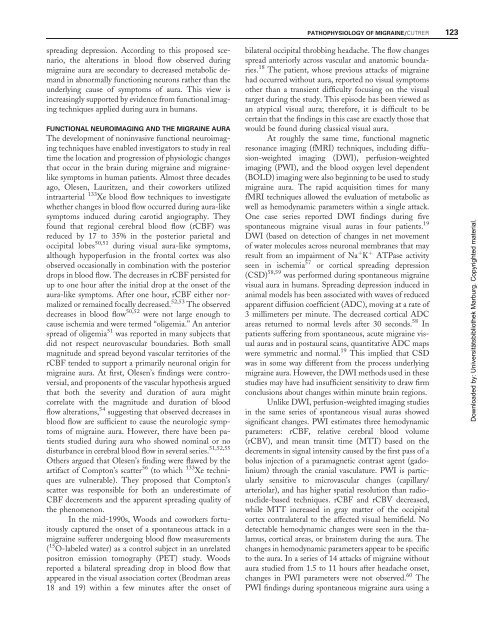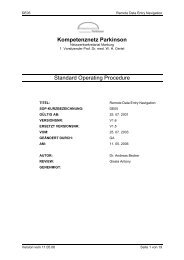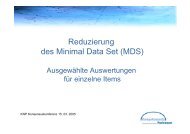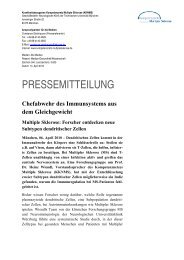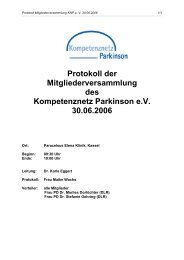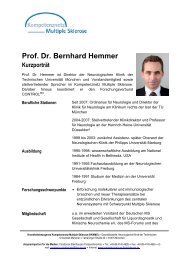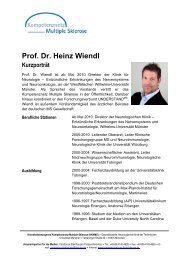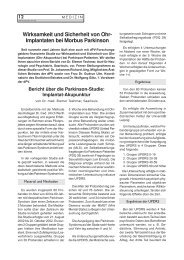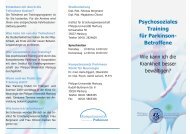Pathophysiology of Migraine - Kompetenznetz Parkinson
Pathophysiology of Migraine - Kompetenznetz Parkinson
Pathophysiology of Migraine - Kompetenznetz Parkinson
Create successful ePaper yourself
Turn your PDF publications into a flip-book with our unique Google optimized e-Paper software.
spreading depression. According to this proposed scenario,<br />
the alterations in blood flow observed during<br />
migraine aura are secondary to decreased metabolic demand<br />
in abnormally functioning neurons rather than the<br />
underlying cause <strong>of</strong> symptoms <strong>of</strong> aura. This view is<br />
increasingly supported by evidence from functional imaging<br />
techniques applied during aura in humans.<br />
FUNCTIONAL NEUROIMAGING AND THE MIGRAINE AURA<br />
The development <strong>of</strong> noninvasive functional neuroimaging<br />
techniques have enabled investigators to study in real<br />
time the location and progression <strong>of</strong> physiologic changes<br />
that occur in the brain during migraine and migrainelike<br />
symptoms in human patients. Almost three decades<br />
ago, Olesen, Lauritzen, and their coworkers utilized<br />
intraarterial 133 Xe blood flow techniques to investigate<br />
whether changes in blood flow occurred during aura-like<br />
symptoms induced during carotid angiography. They<br />
found that regional cerebral blood flow (rCBF) was<br />
reduced by 17 to 35% in the posterior parietal and<br />
occipital lobes 50,51 during visual aura-like symptoms,<br />
although hypoperfusion in the frontal cortex was also<br />
observed occasionally in combination with the posterior<br />
drops in blood flow. The decreases in rCBF persisted for<br />
up to one hour after the initial drop at the onset <strong>of</strong> the<br />
aura-like symptoms. After one hour, rCBF either normalized<br />
or remained focally decreased. 52,53 The observed<br />
decreases in blood flow 50,52 were not large enough to<br />
cause ischemia and were termed ‘‘oligemia.’’ An anterior<br />
spread <strong>of</strong> oligemia 51 was reported in many subjects that<br />
did not respect neurovascular boundaries. Both small<br />
magnitude and spread beyond vascular territories <strong>of</strong> the<br />
rCBF tended to support a primarily neuronal origin for<br />
migraine aura. At first, Olesen’s findings were controversial,<br />
and proponents <strong>of</strong> the vascular hypothesis argued<br />
that both the severity and duration <strong>of</strong> aura might<br />
correlate with the magnitude and duration <strong>of</strong> blood<br />
flow alterations, 54 suggesting that observed decreases in<br />
blood flow are sufficient to cause the neurologic symptoms<br />
<strong>of</strong> migraine aura. However, there have been patients<br />
studied during aura who showed nominal or no<br />
disturbance in cerebral blood flow in several series. 51,52,55<br />
Others argued that Olesen’s finding were flawed by the<br />
artifact <strong>of</strong> Compton’s scatter 56 (to which 133 Xe techniques<br />
are vulnerable). They proposed that Compton’s<br />
scatter was responsible for both an underestimate <strong>of</strong><br />
CBF decrements and the apparent spreading quality <strong>of</strong><br />
the phenomenon.<br />
In the mid-1990s, Woods and coworkers fortuitously<br />
captured the onset <strong>of</strong> a spontaneous attack in a<br />
migraine sufferer undergoing blood flow measurements<br />
( 15 O-labeled water) as a control subject in an unrelated<br />
positron emission tomography (PET) study. Woods<br />
reported a bilateral spreading drop in blood flow that<br />
appeared in the visual association cortex (Brodman areas<br />
18 and 19) within a few minutes after the onset <strong>of</strong><br />
PATHOPHYSIOLOGY OF MIGRAINE/CUTRER 123<br />
bilateral occipital throbbing headache. The flow changes<br />
spread anteriorly across vascular and anatomic boundaries.<br />
18 The patient, whose previous attacks <strong>of</strong> migraine<br />
had occurred without aura, reported no visual symptoms<br />
other than a transient difficulty focusing on the visual<br />
target during the study. This episode has been viewed as<br />
an atypical visual aura; therefore, it is difficult to be<br />
certain that the findings in this case are exactly those that<br />
would be found during classical visual aura.<br />
At roughly the same time, functional magnetic<br />
resonance imaging (fMRI) techniques, including diffusion-weighted<br />
imaging (DWI), perfusion-weighted<br />
imaging (PWI), and the blood oxygen level dependent<br />
(BOLD) imaging were also beginning to be used to study<br />
migraine aura. The rapid acquisition times for many<br />
fMRI techniques allowed the evaluation <strong>of</strong> metabolic as<br />
well as hemodynamic parameters within a single attack.<br />
One case series reported DWI findings during five<br />
spontaneous migraine visual auras in four patients. 19<br />
DWI (based on detection <strong>of</strong> changes in net movement<br />
<strong>of</strong> water molecules across neuronal membranes that may<br />
result from an impairment <strong>of</strong> Na þ K þ ATPase activity<br />
seen in ischemia 57 or cortical spreading depression<br />
(CSD) 58,59 was performed during spontaneous migraine<br />
visual aura in humans. Spreading depression induced in<br />
animal models has been associated with waves <strong>of</strong> reduced<br />
apparent diffusion coefficient (ADC), moving at a rate <strong>of</strong><br />
3 millimeters per minute. The decreased cortical ADC<br />
areas returned to normal levels after 30 seconds. 58 In<br />
patients suffering from spontaneous, acute migraine visual<br />
auras and in postaural scans, quantitative ADC maps<br />
were symmetric and normal. 19 This implied that CSD<br />
was in some way different from the process underlying<br />
migraine aura. However, the DWI methods used in these<br />
studies may have had insufficient sensitivity to draw firm<br />
conclusions about changes within minute brain regions.<br />
Unlike DWI, perfusion-weighted imaging studies<br />
in the same series <strong>of</strong> spontaneous visual auras showed<br />
significant changes. PWI estimates three hemodynamic<br />
parameters: rCBF, relative cerebral blood volume<br />
(rCBV), and mean transit time (MTT) based on the<br />
decrements in signal intensity caused by the first pass <strong>of</strong> a<br />
bolus injection <strong>of</strong> a paramagnetic contrast agent (gadolinium)<br />
through the cranial vasculature. PWI is particularly<br />
sensitive to microvascular changes (capillary/<br />
arteriolar), and has higher spatial resolution than radionuclide-based<br />
techniques. rCBF and rCBV decreased,<br />
while MTT increased in gray matter <strong>of</strong> the occipital<br />
cortex contralateral to the affected visual hemifield. No<br />
detectable hemodynamic changes were seen in the thalamus,<br />
cortical areas, or brainstem during the aura. The<br />
changes in hemodynamic parameters appear to be specific<br />
to the aura. In a series <strong>of</strong> 14 attacks <strong>of</strong> migraine without<br />
aura studied from 1.5 to 11 hours after headache onset,<br />
changes in PWI parameters were not observed. 60 The<br />
PWI findings during spontaneous migraine aura using a<br />
Downloaded by: Universitätsbibliothek Marburg. Copyrighted material.


